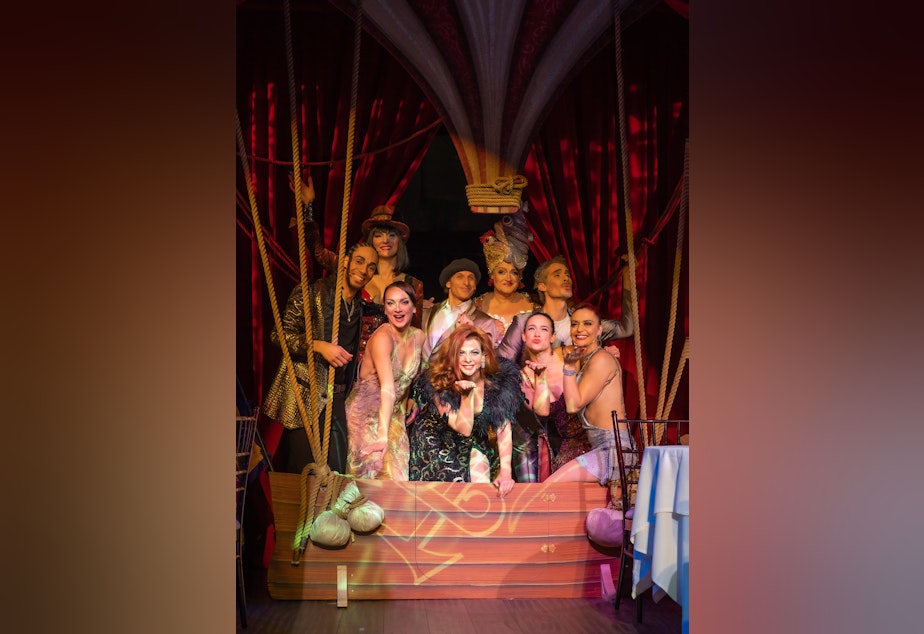Reporter's Notebook: Teatro Zinzanni — a theatrical experience that feels truly post-pandemic

As an arts and culture reporter, I spend a lot of time going to galleries, theaters, concerts, events. And in these past few months, I’ve heard over and over again that the arts are “back.” But something still felt off.
On Tuesday night, at Teatro Zinzanni, everything clicked back into place. And I had my first revelation that the arts are truly back.
When we think of the arts, one aspect that cannot be overlooked is the communal nature of experiencing art. Sure, Hollywood elites pushed back on the idea of blockbuster movies bypassing theaters and streaming into our homes for financial reasons. But for many of the directors who we would consider to be auteurs, the resistance to in-home films was rooted in their desire for their art to be viewed on big screens with high-end sound systems and live audiences who experience the films together.
Even now that we can go to these theaters in person, we still exhibit pandemic induced self-disciplining. My family and I went to a packed theater to see "Wakanda Forever," and most people left an empty “courtesy” seat between themselves and strangers. I’ve been to art galleries where tickets are staggered to ensure only so many people are in exhibits at a given time. I’ve also been to galleries with limited entry and have observed galleries that require advanced ticketing as opposed to unscheduled visitors.
None of this is to say that these precautions are not warranted. Covid is still here, as well as RSV and influenza. There is plenty of reason for caution, especially for those with compromised immune systems. But, for better or worse, our government has decided it is time to move on, and, observationally speaking, it feels like even as we are forced back to work and school as if everything is OK, the arts world still seems to carry the lingering effects of the pandemic.
Then, I went to Teatro Zinzanni. Coming into the show, I didn’t have many expectations. I was aware of what I may see, but, as a reporter, I’ve molded myself into the habit of not reading the thoughts of critics before attending shows. I like to experience art for myself, which is admittedly difficult in the age of social media.
The show takes place in a nondescript building in SODO, smack in the middle of an industrial area. But walking into the building was like stepping into a portal that transports one to a fantastical world of lavish costumes and lively conversation. And I don’t just mean patrons conversing amongst themselves – it was with the performers, who were scattered through the tables mingling with seated guests.
Sponsored
As I took my seat, I was immediately approached by a costumed individual who offered charming banter, who claimed to be the chef (she absolutely was not!). Our exchange was delightful, and she casually touched my shoulder, which I noticed immediately.
My work often brings me into spaces with performers, but these are usually closely monitored, manicured situations with rapid Covid tests and mandatory masking. Here, the performers were making rounds table to table and engaging audience members, passing around props, and later in the show – playing practical jokes!
When you go to a show in a theatre, there is a wall that divides audience from performer. Even when cast members appear from beyond the audience, and perform their way to the stage, this wall still exists. Furthermore, in theatre, be it plays or movies, the audience remains stationary. Viewers have their bubble, and they mostly remain in their self-contained space throughout the show.
In a recent experience, at Cafe Nordo, performers similarly used audience engagement in their show. The Cafe Nordo stage was set in the front of the room, but portions of scenes would happen in various places around the audience. At select times during the show, audience members (one section at a time) were encouraged to leave their seats and move through rooms to view story related art installations that doubled as vessels for serving food. During these moments, people were allowed to take pictures. It was highly creative, and a great experience.
But Teatro took that experience to the next level. The main stage was nonexistent. They moved multiple types of stages, which were used in unique ways, to the middle of the space at different times. I don’t want to spoil the show, but they did this in a creative way.
Sponsored
This show didn’t perform around the audience – they performed with the audience. Throughout the show, people were pulled from the audience and incorporated into different aspects of the performance. There were a couple of bald gentlemen whose heads hilariously became reoccurring props.
There were somber moments when we all sang together, tender moments when we danced together, a slow dance to be specific. And in that moment, as I held my mother-in-law close and gently swayed back-and-forth, I looked around the room and realized that everyone was embracing someone. And with everything happening in the world, and everything we have collectively experienced these last few years, it felt good to be having that moment with other people.




